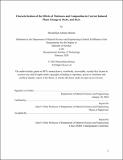Characterization of the Effects of Thickness and Composition in Current Induced Phase Change in Sb₂Se₃ and Sb₂S₃
Author(s)
Bolzan, Maximilian Adriano
DownloadThesis PDF (30.74Mb)
Advisor
Hu, Juejun
Terms of use
Metadata
Show full item recordAbstract
Phase-change memory is a promising new field for the world of memory storage, but current limitations such as slower switching speeds than current forms memory like random-access memory (RAM) and flash memory, have made the implementation of phase-change memory infeasible. Antimony triselenide (Sb₂Se₃) and antimony trisulfide (Sb₂S₃) are two materials that have already been investigated for their applications in solar cells, thermal storage, and other photovoltaic . Samples of Sb₂Se₃ and Sb₂S₃ were produced at two varying thicknesses each, 30 nm and 200 nm in order to determine the optimal combination of thickness and composition. Optimal performance was determined by the endurance of the samples when undergoing current induced phase changes and the difficulty in switching between crystalline and amorphous states. Through a combination of optical microscopy, Raman spectroscopy, and scanning electron microscopy, the samples were characterized and analyzed for their performance in phase cycling. The 200 nm samples and Sb₂Se₃ samples generally demonstrated a greater performance in endurance and lack of dewetting after phase cycling.
Date issued
2024-02Department
Massachusetts Institute of Technology. Department of Materials Science and EngineeringPublisher
Massachusetts Institute of Technology